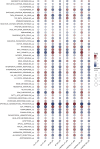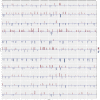Molecular portraits of colorectal cancer morphological regions
- PMID: 37956043
- PMCID: PMC10642970
- DOI: 10.7554/eLife.86655
Molecular portraits of colorectal cancer morphological regions
Abstract
Heterogeneity of colorectal carcinoma (CRC) represents a major hurdle towards personalized medicine. Efforts based on whole tumor profiling demonstrated that the CRC molecular subtypes were associated with specific tumor morphological patterns representing tumor subregions. We hypothesize that whole-tumor molecular descriptors depend on the morphological heterogeneity with significant impact on current molecular predictors. We investigated intra-tumor heterogeneity by morphology-guided transcriptomics to better understand the links between gene expression and tumor morphology represented by six morphological patterns (morphotypes): complex tubular, desmoplastic, mucinous, papillary, serrated, and solid/trabecular. Whole-transcriptome profiling by microarrays of 202 tumor regions (morphotypes, tumor-adjacent normal tissue, supportive stroma, and matched whole tumors) from 111 stage II-IV CRCs identified morphotype-specific gene expression profiles and molecular programs and differences in their cellular buildup. The proportion of cell types (fibroblasts, epithelial and immune cells) and differentiation of epithelial cells were the main drivers of the observed disparities with activation of EMT and TNF-α signaling in contrast to MYC and E2F targets signaling, defining major gradients of changes at molecular level. Several gene expression-based (including single-cell) classifiers, prognostic and predictive signatures were examined to study their behavior across morphotypes. Most exhibited important morphotype-dependent variability within same tumor sections, with regional predictions often contradicting the whole-tumor classification. The results show that morphotype-based tumor sampling allows the detection of molecular features that would otherwise be distilled in whole tumor profile, while maintaining histopathology context for their interpretation. This represents a practical approach at improving the reproducibility of expression profiling and, by consequence, of gene-based classifiers.
Keywords: cancer biology; colorectal cancer; human; intra-tumor heterogeneity; morphology; transcriptomics.
© 2023, Budinská et al.
Conflict of interest statement
EB, MH, TI, MM, RN, BB, DA, MR, LZ, OS, JF, MD, PB, ST, VP No competing interests declared
Figures















Update of
- doi: 10.1101/2023.01.24.525310
- doi: 10.7554/eLife.86655.1
- doi: 10.7554/eLife.86655.2
References
-
- Amin MB. In: AJCC Cancer Staging Manual. Amin MB, Edge SB, Gress DM, Meyer LR, editors. Chicago IL: Springer; 2017. American Cancer society; pp. XVII–1032.
-
- Bosman FT. WHO Classification of Tumours of the Digestive System. Lyon: International Agency for Research on Cancer; 2010.
-
- Budinska E, Bosman F, Popovici V. Experiments in molecular subtype recognition based on histopathology images. 2016 IEEE 13th International Symposium on Biomedical Imaging; 2016. pp. 1168–1172. - DOI
Publication types
MeSH terms
LinkOut - more resources
Full Text Sources
Medical

